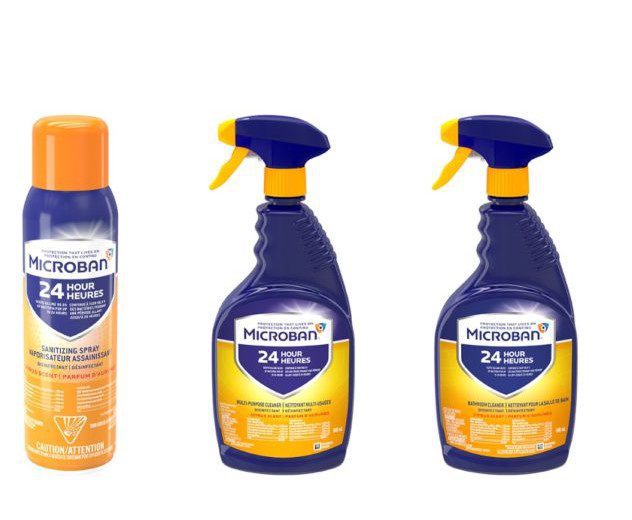Microban
Microban International and Cosentino introduced antimicrobial Silestone Countertops back in 2005. The kitchen and bath counters are made with Microban, an antimicrobial agent engineered into the product.
Media coverage of deadly diseases, from ebola outbreaks in Africa and the SARS epidemic back in 2003 to recent reports of bird flu in Asia and the genesis of superbugs in hospitals and the latest outbreak of COVID-19 virus, also pique our concern for cleanliness.
“Clearly, there is more media attention to infectious diseases in the last 10 to 15 years,” says Dr. Anthony Schryvers, a professor of microbiology and infectious diseases at the University of Calgary.
“Most people don’t have a perfect scientific background . . . there’s a fear of the unknown and that fuels things.”
This sanitizing trend raises the question: Can we make our home a germ-free environment? Should we even try?
Of course, say antimicrobial companies. Not so fast, say infectious disease experts.
Microban is an industry leader in antimicrobial products. The company works with leading home brands to engineer an antimicrobial cell-wall penetrant (also called Microban) into products from toilet seats to mousepads.
Microban Principle of Work
Microban works by rendering harmless certain bacteria and molds that come into contact with it.
You can buy CorStone sinks with Microban, Carpet One rugs with Microban, Johnson & Johnson toothbrushes with Microban handles, Fellowes mouses, mousepads, and keyboards with Microban.
The company has more than 700 products on the market, distributed through partners.
Just don’t buy these items hoping they’ll make you healthier. Microban is careful not to claim the substance protects users from diseases.
“Products that are engineered with Microban protection have an added level of protection against micro-organisms that can cause things like stains and odors and deterioration of the product,” says Billy Henry, president of Microban’s Americas division.
“It’s not a self-cleaning mechanism. It’s an added level of protection, which makes it easier to do the clean-up.”
In other words, what you’re getting is a product that makes it harder for bacteria to thrive on its surface, not a product that protects you from salmonella or E-coli bacteria, for
example.
Ultimately, you’re paying for a sink that will take longer to start smelling or a bathtub that will take longer to start growing pink mold.
Such products should not be confused with antibacterial cleaners.
Mr. Clean, for instance, actually claims to kill 99.9 percent of bacteria that cause food-borne illnesses.
Still, demand for Microban products is on the rise.
The company says its products have been successful because consumers want extra protection against “damaging micro-organisms,” even though the micro-organisms in question are only damaging to the product, not necessarily to the homeowner.
“What we’ve seen is just a tremendous jump in usage of antimicrobial products,” says Henry.
“What that tells us is that consumers have become basically happy and satisfied with the performance of the pioneer products (like antibacterial soaps and toothpaste). . . . They’ve been using these products, and they’ve worked, and so now they’re reaching out and branching out and looking for additional products with antimicrobial protection.”
Experts caution against jumping on the microbial banish-wagon, however.
“I think the antimicrobial countertop is total overkill,” states Dr. Mark Loeb, an associate professor at McMaster University, microbiology and infectious diseases.
He would tell consumers to save their money and invest in washcloths to wipe down their counters instead. Loeb says our best defenses against household germs are still “basic simple precautions that your mother taught you.”
Wash your hands with soap and water. Follow safe food preparation practices. Regularly clean your kitchen and bathrooms.
Another good defense? Knowledge.
“It’s easy to scare people if they don’t understand things,” adds Dr. Schryvers.
And the reality is households are not the places with the highest number of germs.
Hospitals and daycare centers harbor more microbes.
Even friends and family transport far more pathogens than furniture and faucets.
“The worst source of infections are other humans,” Loeb says.
Unfortunately, it’s not yet possible to buy antimicrobial friends or ensure your buddies remember to wash their hands after wiping.
The one thing scientists and marketers agree on: “It’s a microbial world,” states Schryvers.
“There are so many bacteria in the air; there are so many micro-organisms in our environment,” says Henry.
“What (Microban is) providing is an innovation that brings convenience to consumers by creating a product, an environment, a surface, that is cleaner, that is easier to (keep) clean.
“Really, it’s up to each consumer to decide whether or not they need that added level of protection or that added level of help.”


























